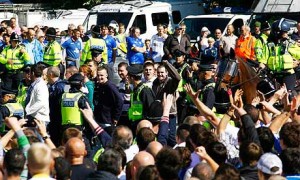Hooliganism Will Not Go Away – News Report

Millwall supporters are escorted by police officers before the Championship match against newly promoted Leeds United at Elland Road. Photograph: Craig Brough/Action Images
They hunt in packs, fuelled by cocaine, hooked on violence and occasionally wielding chains. Some are as old as 65. They use mobile phones and the internet to arrange showdowns with rival “firms” at agreed locations away from prying CCTV cameras and police surveillance. This is the profile of the 21st-century football hooligan, a breed of “fan” who, although decreasing in numbers and visibility, is recognised by the football authorities and police as never having gone away.
Less than a fortnight ago, Danny Scriven, a 26-year-old postman, and 21-year-old Kali Hagenstede – two members of the Tottenham firm the Yid Army – were jailed for 15 months and given six-year banning orders (keeping them away from football matches) for being part of a 20-strong mob that smashed up The George, a pub in Holloway used by Arsenal’s firm the Herd, after Spurs lost the north London derby last October. Last Wednesday, 19-year-old Callum Ellis was given a maximum five-year banning order by Leeds magistrates for being the leader of a group of Bradford City hooligans who call themselves the Young Bradford Ointment. There has been a worrying series of violent, football-related incidents in the past three months.
Diligent and effective policing and widespread use of surveillance cameras make sure there is rarely any trouble at matches. Millwall fans travelling to yesterday’s game at Elland Road had to pick up their tickets from a motorway service station on the way into Leeds, which kept them off the trains, and they were escorted in and out of the ground. Police with dogs, riot gear and video equipment set up a no-go area after the game to keep Leeds followers away from the 550 or so Millwall fans. Police reported only seven arrests, which was seen as a triumph.
Away from the ground it is
a different story. A senior official at one of London’s most prominent clubs, who has been involved in the game since the dawn of hooliganism and who did not wish to be named, toldObserver Sport: “If anyone thinks the problem has gone away they are naive. The internet provides an easy way for hooligans to arrange meetings. This is gang violence that attaches itself to sport. It is naive to think football still doesn’t provide an opportunity for a ruck – it does.”
Risk supporters, as they are officially called, consider themselves tribal families who pass on the taste for fighting to their sons and grandsons, and will probably never be removed despite the continuing efforts of the government, police and football authorities. “The normal paying public wouldn’t understand it,” says Wally, a 46-year-old who was once a prominent force in Birmingham City’s firm the Zulus. “We class ourselves as family. The Zulus have been together for over 25 years now. We go out together, drink together, go to weddings and funerals, and are in business together. We look out for each other.”
A glance on internet chat forums and social-media sites offers evidence that many clubs’ gangs still exist throughout the Premier League, Football League and even in the non-League pyramid. Precisely how active they are is difficult to gauge. But the spate of recorded incidents since May and ongoing intelligence work by the authorities indicate the police still have a big job on their hands every week.
PC Pete Dearden, Arsenal’s football intelligence officer, says: “At a high-profile game at Arsenal where there are 60,000 people coming, we are looking at 150 to 200 who are part of the risk supporters group. I have some who are in their sixties and might earn £100,000 a week in the City. Many don’t go to the game because they can’t get membership or are banned, but they still attach themselves. What we have is a decreasing minority of quite well-organised groups seeking disorder with like-minded individuals a long time before and after the game.
“You might get a situation where Arsenal risk supporters sit in a pub near a stadium, then they might meet at a transport hub – say King’s Cross for northern teams – in the hope that, even if it’s a CCTV-dominated area, we’re just not going to find out about it.”
Dearden says that while there is a hooligans’ code, their preferred drug has changed. “After a fight, they might go around the corner to the pub for a drink. Physically, the drive used to be alcohol that fuelled this anti-social behaviour. Today, cocaine is massively in abundance. It gives them that strength of character to go into situations where otherwise they might have been frightened. It makes them braver. Cocaine is the choice of a modern-day hooligan.
“The best way for me to curtail the activities of my risk group [in Islington, Arsenal’s borough] is to cut off their supply of cocaine – with good intelligence, arresting the person supplying them.”
Wally, who has now retired from the frontline and says he prefers to watch Birmingham City from an executive box, concurs. “It is coke now – that’s always about. There is a younger firm coming through,” he says. “They are 15-, 16-year-olds who want to get into it. They’ve read the books, want to buy the clothes and they’ve heard the reputations of their dads and uncles.”
While trouble can still flare around high-profile games, the preferred location for fighting and disorder is away from stadiums, with British Transport Police reporting a 49% increase in arrests year on year, and 83 banning orders issued for incidents on the rail network in 2008-09, the latest season for which details are available.
On the eve of the new football season this moved the BTP to announce a crackdown on troublemakers and a determination to issue more banning orders. Stephen Thomas is the BTP’s assistant chief constable in charge of football operations. He says: “The number of incidents has gone up and so are our prosecutions. During the season, we prosecute about 20 a week – everything from a caution or fixed penalty notice to putting them before the court.”
Fifa’s inspectors visit England this week to run the rule over the 2018 World Cup bid. How damaging does Thomas think any problems might be to England’s hopes of hosting the tournament? “Fifa are mature and sophisticated enough to look at the big picture, not just pick up on isolated incidents because they don’t reflect the behaviour of football fans in stadiums,” he says. “Look at the World Cup in South Africa; there was no one arrested for football-related trouble.”
England’s main rivals in the bidding process are Russia, where football hooliganism is a far bigger problem.
Home Office figures for the 2008-09 season show an average of only 1.18 arrests per match, an overall total of 3,752 from the 38 million people who attended games in England and Wales that year. The authorities aim to keep it that way, although they remain vigilant and will be concerned by the outbreaks of violence this summer.
A Football Association spokesperson says: “In reality, football is safer than it has ever been and the great majority of people are able to enjoy football in a safe and friendly environment. Of course there is a very small minority of individuals who will cause disorder on occasion and we have strong legislation in place to deal with these people. The improvements in stewarding, appropriate policing, state-of-the-art CCTV systems and the efforts of clubs and leagues have added greatly to making football a fan-friendly environment.”
Privately, the FA, BTP, the police on the ground and the government understand they have to remain wary. They point to last August’s trouble between West Ham and Millwall during a Carling Cup tie in east London in which an innocent Millwall supporter was stabbed, West Ham fans invaded the pitch and police made 64 arrests. West Ham were fined £115,000.
Every week Dearden gathers intelligence from his counterparts at other clubs, “spotters” at train and motorway service stations, the transport police, traffic wardens, the public and paid informants on the inside of the Herd so he can grade the risk of potential violence and call in police resources.
Yesterday, Blackpool were at the Emirates. Dearden says: “We knew there would be around 20 of Blackpool’s risk supporters. My Lancashire colleague knows who they are and I asked about Arsenal’s risk supporters’ intentions. We pay informants; there is a network of them across hooligan groups in England and if they give us good information we pay them. It’s like having an undercover officer among them. Our intelligence is better than ever. If they were to fight in a pub and it was captured on CCTV I can identify individuals.”
Dearden gave evidence in the case against Scriven and Hagenstede, the jailed thugs. The court heard they had come to the pub armed with a dustbin, a pole and barstools, but the Herd had moved on from the pub. Dearden says: “That’s our most high-risk game. It was a midday fixture, so by 6.30pm everybody had gone home. The Spurs hooligans were still in their pubs in Haringey or the West End. But we had intelligence that they might come to the area.
“Our risk supporters had moved from one location to another and the Spurs risk supporters came on the Underground undetected, because we can’t check every train. About 20 of them went to our risk pub, which is normally frequented by our hooligans, and attacked normal Saturday night punters.
“I’d suggest that was cowardly because its easy to attack a defenceless pub. It’s the height of disrespect in the hooligan world to turn over the opposition’s pub.
“CCTV evidence led to two of them receiving a 15-month prison sentence, which reflects that the judge has an understanding of the organised pre-planned ferocity of the incident.”
The tipping point for English hooliganism came at Euro 2000, when rioting in Charleroi led to Uefa threatening England with expulsion and forced Tony Blair, then prime minister, to apologise. Parliament then passed the Football Disorder Act 2000, giving courts the power to issue banning orders and confiscate passports to keep troublemakers away from games.
A Home Office spokesperson says: “The strategy works well and there has been no significant English football violence overseas since Euro 2000. The arrangements are tried and tested throughout each football season, as around 100,000 English fans travel to international and European club matches overseas.”
The hooligans agree. Wally says: “There used to be instances before where you could get arrested on the morning of a match and be out by kick-off with a £50 fine and a slap on the wrist. Now it’s the first arrest and a three-year ban, minimum. It’s not just whether you can get away with it on the day. Because of CCTV, six months later your door’s liable to get a knock.”
But Malcolm Clarke, chairman the Football Supporters’ Federation, claims that banning orders are draconian. He says: “There can be inappropriate use of the powers. We have asked for a judicial review and I would say the pendulum has swung too far the other way.”
The authorities, though, argue that the battle to control hooliganism and prevent a return to the dark days requires stringent measures. Dearden is sure the problem will never completely go away. “It would need a culture change. The minute we think we’ve got it under control there will be trouble. Polish fans attacked Arsenal fans recently during a pre-season friendly and a lot of countries have problems. With the European Championship in Poland coming up, I fear what may happen.
“If you poke the English animal enough it will rear its ugly head. South Africa [during the World Cup] was never going to be a problem because of the distance. We don’t want that disease returning.”
